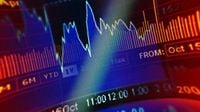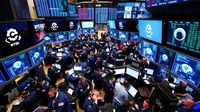The Rheinmetall stock continues its consolidation, albeit at a moderate pace compared to the previous price surge. Since hitting a notable consolidation low of 1,206 Euro on March 20, 2025, there have been no significant setbacks. The defense stock has established a new short-term resistance at 1,361/1,370 Euro, which has played a role on three of the last four trading days. Closing at 1,350 Euro on the XETRA exchange yesterday, the stock is currently trading at 1,349.50 Euro on Tradegate this morning, March 28, 2025.
From a technical standpoint, the upward trend of the Rheinmetall stock (WKN: 703000, ISIN: DE0007030009) remains intact, although the distance to the moving averages indicates an overstretched movement. The steeply rising EMA 20 at 1,258 Euro has yet to be seriously tested. Meanwhile, the EMA 50 at 1,045 Euro and the EMA 200 at 716 Euro lie far below, underscoring the extent of the rally. The Bollinger Bands have expanded significantly, and the stock is currently moving in the upper third of the band, suggesting an overbought condition. This interpretation is confirmed by the RSI, which has a current value of 68.42, close to the critical 70 mark. The Chaikin Money Flow (CMF) stands at 0.22, remaining in positive territory but below previous buying frenzy levels, indicating a declining capital influx. If this trend reverses downward, it could become critical.
On the downside, the zone around 1,182 to 1,218 Euro remains a crucial technical level for the future trend of Rheinmetall shares. Should this be breached, the open gap from March 3 at 1,012.50 to 1,077 Euro could come into play, along with deeper technical support zones. Resistance is currently evident well below the all-time high of 1,483 Euro, with selling pressure likely to emerge at 1,361/1,370 Euro and 1,391/1,407 Euro before another attempt at the all-time high can be made. A breakout above this level would only be realistic with convincing momentum; without a prior deeper consolidation, the risk of a setback increases.
On March 28, 2025, at 09:00, the chart signal TOP Momentum occurred for Rheinmetall, indicating a long signal. However, the stock lost 4.0 percent in the XETRA session, reaching 1,296.50 Euro. Rheinmetall AG is an international automotive supplier and armaments group headquartered in Düsseldorf, Germany. Founded in 1889 by Heinrich Ehrhardt, the company employs 28,054 people worldwide. In the fiscal year 2023, Rheinmetall achieved a turnover of 7.18 billion Euro, a 12% increase compared to the previous year, with a profit of 535 million Euro and a market capitalization of 21.17 billion Euro.
Among the largest shareholders are Capital Research & Management Co. (World Investors), The Vanguard Group, Inc., and Fidelity Management & Research Co. LLC. In 2021, Rheinmetall restructured into five divisions: Weapon & Ammunition, Electronic Solutions, Vehicle Systems, Sensors & Actuators, and Materials & Trade, moving away from its previous division into Automotive and Defence. The subsidiary Kolbenschmidt Pierburg AG is responsible for segments including air supply, emission reduction, pumps, pistons, and engine blocks in the automotive sector. In defense, Rheinmetall manufactures technologies in armored vehicles, ammunition, air defense, and defense electronics.
The company’s history is marked by the production of military products, beginning with the field-serviceable recoil gun in 1898. After interruptions in arms production following the World Wars, Rheinmetall resumed manufacturing defense-related products in the 1950s. The first Leopard 2 main battle tank, a significant product in Rheinmetall's portfolio, was developed in 1979. In subsequent decades, the company expanded its civilian activities, particularly through the acquisition of Pierburg GmbH and the merger with Kolbenschmidt AG in the late 1990s. Rheinmetall's internationalization, especially in American and Asian markets, remains a central strategic goal, led by Armin Papperger as Chairman of the Management Board.
Despite recent losses, analysts have been adjusting their estimates for Rheinmetall upwards. On March 28, 2025, the stock fell approximately 2.6%, reaching 1,314.50 Euro. Analysts believe the stock is still in an upward trend, although there are concerns that ongoing peace negotiations in Ukraine could negatively impact the defense sector. The EU has expressed its unwillingness to accept a ceasefire based on current conditions, while Russian President Vladimir Putin has laid out terms that complicate negotiations.
However, analysts remain optimistic about Rheinmetall's potential. Morningstar forecasts an initial price target of 2,000 Euro, potentially reaching 3,000 Euro by 2030. Morgan Stanley's estimates also reflect a bullish outlook, with a target of 2,200 Euro. The market projects a profit of 2.456 billion Euro (EBITDA) for the current year, with expectations of 3.378 billion Euro in 2026 and 4.571 billion Euro in 2027, indicating significant growth.
Currently, the Rheinmetall stock is in the lower third of the Dax, showing a downward movement of 1.33% on March 28, 2025, with a current value of 1,332.00 Euro, down from 1,350.00 Euro the previous day. The stock's performance places it in the middle of the Dax, with a market share of 2.85%. As of now, the stock is 10.18% below its 52-week high of 1,483.00 Euro, while the 52-week low stands at 437.50 Euro. The total market value of all freely available Rheinmetall shares is currently 58.64 billion Euro, significantly lower than the highest market capitalization in the Dax, which belongs to SAP at 290.77 billion Euro.
In summary, while recent trading days have shown some consolidation and minor setbacks, the overall outlook for Rheinmetall remains positive, supported by strong analyst estimates and a robust business model. The market's perception of the stock continues to be influenced by external factors, including geopolitical developments and industry trends.






